Grub Hub
Published January 2024
By Eric Howerton | Photos by Brent Fuchs | 15 min read
The display cases in a certain first-floor lobby on the Stillwater campus of Oklahoma State University feature an impressive archive of products. A closer look behind the glass reveals a veritable market of granola, soda, eggs, bologna, olive oil, kolache, pretzels, pasta, wheat flour, coffee, barbecue sauce, fruit preserves, sausage patties, pancake mix, beef jerky, beer, wine, and more.
Other than the fact of their edibility, these products all have one thing in common: They are among more than a thousand food products that exist because they were developed right here in Stillwater at the Robert M. Kerr Food and Agricultural Products Center, or FAPC, on the OSU campus.
But FAPC is more of an opportunity than it is a building, a place, or an academic department. It is neither a commercial copacker, nor a business and marketing school, nor a full-time production facility, nor a butcher shop, nor a consulting firm. And yet, somehow, FAPC is a little bit of all those things at the same time.
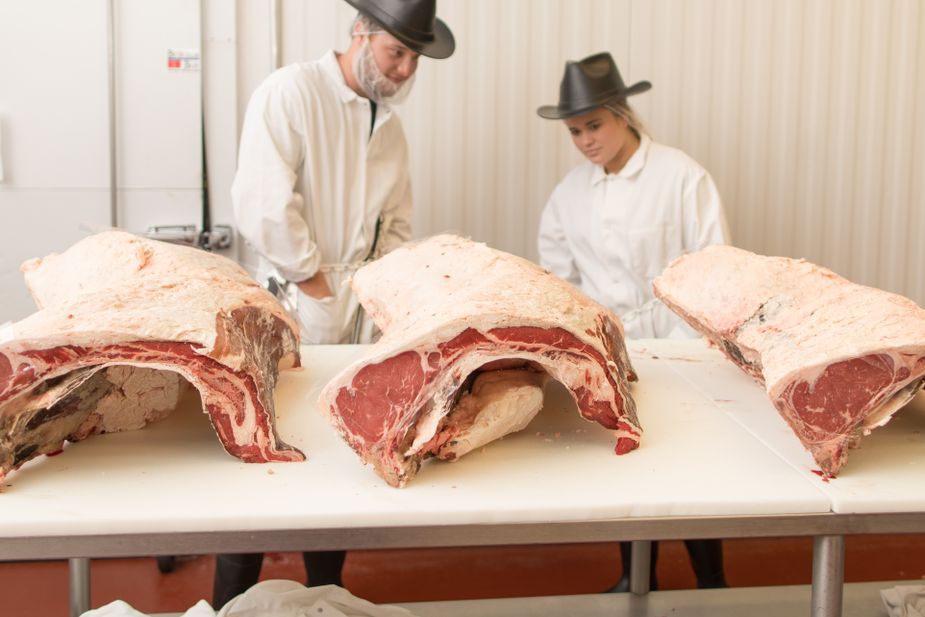
Students Joshua Hering and Brooklyn Wurm judge beef loins at the Robert M. Kerr Food and Agricultural Product Center at Oklahoma State University in Stillwater. Most of the students wear cowboy-style hard hats at the meat plant. Photo by Brent Fuchs
Dedicated in 1996, FAPC is housed under OSU’s Division of Agricultural Sciences and Natural Resources, functioning as a hub between food sciences education and the food industries. Equipped with containment pens for sheep, hogs, and cattle; animal harvesting and processing rooms; test kitchens; raw and cooked-food preparation rooms; packaging stations; smokers; steamers; macerators; freezers; and state-of-the art research labs, FAPC intimately familiarizes students with food industry settings and operations.
Fortunately for Oklahomans, FAPC’s benefits extend beyond the campus. In keeping with the spirit of OSU’s land-grant mission, access to agricultural research and expertise is afforded to the greater community at large. FAPC staff and faculty help students, small business owners, and corporate food scientists conduct focused research projects that resolve food industry queries and problems. By opening its doors to private businesses and non-students, FAPC increases access to local expertise in food process engineering, agribusiness, oils and oilseeds, food safety, microbiology, horticultural processing, facilities management, and more.
“This collection of people from all these different departments—who think differently or are trained differently—are all over here in one little pool,” says FAPC director Roy Escoubas of faculty members who step outside their home departments to assist with FAPC projects. “They’re the most remarkable team of people. In this setting, they team with other faculty members from other departments, other types of disciplines and staff, all on a peer basis.”
Joel Jackson, the meat pilot plant manager, notes that FAPC helps people, as he says, “work through the hiccups” in launching new business or retail items, writing business plans, following safety and sanitation protocols, and performing feasibility studies. Business-minded individuals who work with FAPC usually enroll in its Basic Training for Food Entrepreneurs program to learn the process of bringing a product to market.
Escoubas also mentions that while it’s true FAPC benefits the community, the community benefits FAPC, too. By collaborating with food scientists, developers, testers, and others from private industry, FAPC faculty and staff directly expand their knowledge base by staying current on trends, technologies, and developments. This knowledge can then trickle down to OSU students and other FAPC-contracting businesses. Its fourteen-member Industry Advisory Committee of appointed entrepreneurs and experts in the food industry offer counsel and guidance for the center.
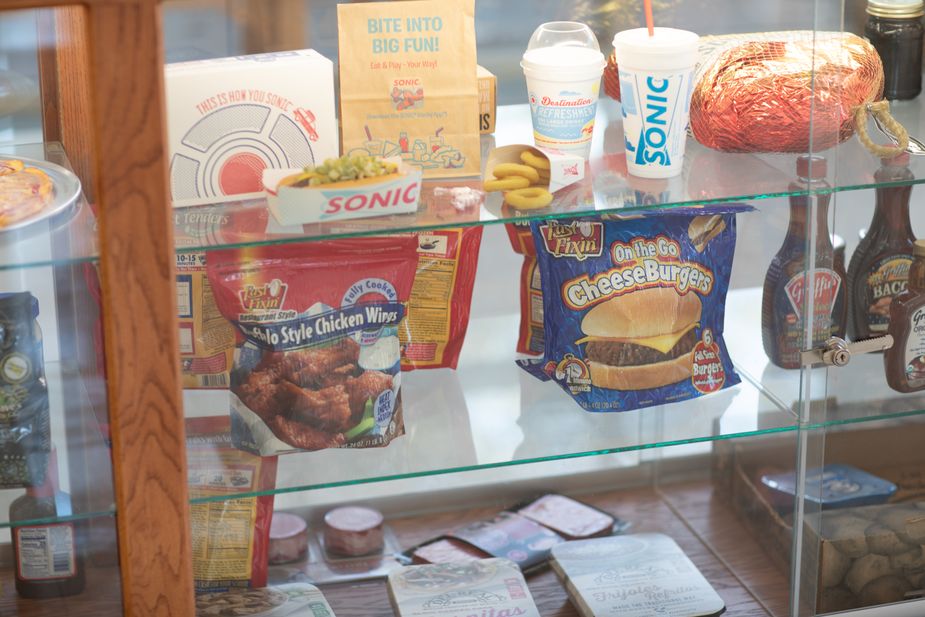
The first floor lobby at FAPC features an array of glass-encased products that were developed there. Photo by Brent Fuchs
A recent example of the way FAPC bridges industry, education, and research is the Meat Mastery program, which consists of an intensive butchery course hosted in collaboration with the Osage Nation. During the course, harvesters hone their skills in value-added manufacturing and meat fabrication—the process of breaking down an animal into consumer cuts and boned meat—while receiving instruction on master-level butchering techniques, effective sanitation methods and products, and industry-specific safety equipment. They also observe the slaughter and fabrication of a buffalo.
Funded by a USDA workforce training grant, the program was designed and is taught by OSU animal sciences professor Ravi Jadeja, plant manager Jackson, and assistant plant manager Cole McKinney. A former OSU undergraduate in animal science, McKinney returned to OSU in 2022 to earn his master’s degree in meat science and operate the plant with Jackson. Working with FAPC during his undergraduate years helped McKinney develop the aptitudes and business connections needed to land an industry job.
“FAPC helped with networking, understanding how the industry works, time management, and cost-savings projects,” he says.
Participants in Meat Mastery attend class five days a week for five weeks. OSU provides housing for registrants, and the grant awards students who complete the course a $2,000 stipend to offset lost wages. Ultimately, the stipend more than covers the cost of the course itself.
Chris Hoagland, head butcher at Carnivore Cuts Custom Butchery in Haskell, was one of twenty red-meat harvesters who enrolled in Meat Mastery. Hoagland has more than a decade of butchery experience under his apron and has been operating Carnivore Cuts with Austin Owens since October 2021. Meat Mastery helped Hoagland earn additional certifications that will eventually allow him to offer more cuts and products.
“I didn’t realize how important a butchery job was before taking the class,” Hoagland admits. “I thought it was just another job, but Meat Mastery definitely made me take a lot more pride in my work. It boosted my confidence and let me know I’m moving in the right direction.”
The program was so invaluable, Hoagland added, that he intends to send his Carnivore Cuts apprentice to Meat Mastery this summer. In the meantime, he’s actively passing on the lessons he learned, and he credits the program for improving his training approach.
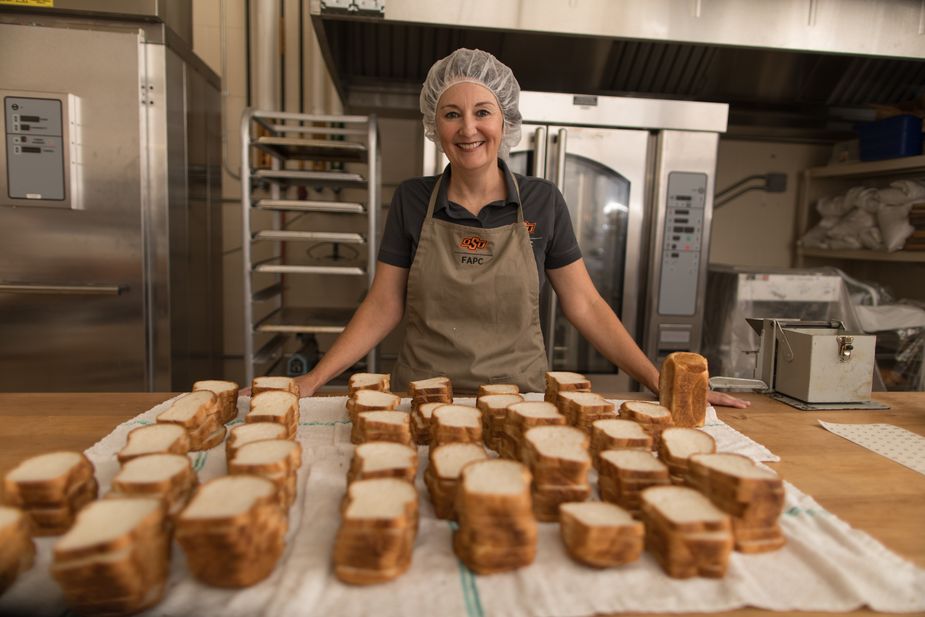
Reneé Albers-Nelson, manager of the cereal grains program at FAPC, grades bread made from student-grown wheat samples. Photo by Brent Fuchs
Oklahoma’s fertile soil, extended growing season, and open grasslands are well known for the advantages they offer farmers and ranchers. Oklahoma is one of the top twenty-five producers of comestible products in the nation and the second-largest producer of beef after Texas. Wheat, corn, soy, hay, peanuts, pecans, and sorghum, as well as hogs, chickens, lamb, and dairy from Oklahoma are sold in restaurants, cafés, bakeries, and markets nationwide. But it wasn’t always easy for students, entrepreneurs, and food scientists to access industry information or enter the market themselves. Before 1996, there were no facilities in the state where a wide swath of agricultural commodities could be tested, developed, processed, fabricated, packaged, and preserved.
In a 1991 open letter to the state legislature, State Senator Robert M. Kerr expressed concern that Oklahoma was producing nearly $3 billion worth of agricultural commodities a year, but more than 90 percent of these goods were sold to out-of-state buyers at wholesale prices. Kerr emphasized that by processing less than 10 percent of these products locally, Oklahomans were not only paying to freight their capital across state lines, they were also missing out on potential revenue streams when these goods were manufactured into value-added products and shipped back to Oklahoma for resale. In effect, Oklahoma had the agricultural yields to support a food processing industry, but agriculturalists and entrepreneurs did not have access to the facilities or support needed to enter the retail space.
In his letter, Kerr was adamant that state government address the void, which he said was preventing Oklahomans from capitalizing on their labor. Kerr’s plan was to raise funding for a modern expansion of the extension efforts modeled by the Morrill Act of 1862, the Hatch Act of 1887, and the Smith-Lever Act of 1914. When the Oklahoma Food and Agricultural Products Research and Technology Center opened, Kerr’s vision for advancing Oklahoma’s food industry was realized.
Now, OSU grads and undergrads get hands on red-meat fabrication experience in FAPC facilities—most often when enrolled in courses taught by Gretchen Mafi, Morgan Pfeiffer, and Ranjith Ramanathan. One of Joel Jackson’s major accomplishments as meat pilot manager was resuscitating the Cowboy Meats initiative, a market endeavor that sells student-fabricated meats and sausages. Open on Fridays, Cowboy Meats is less a for-profit enterprise than it is a way to partially recoup the cost of procuring the animals needed for the meat science courses.
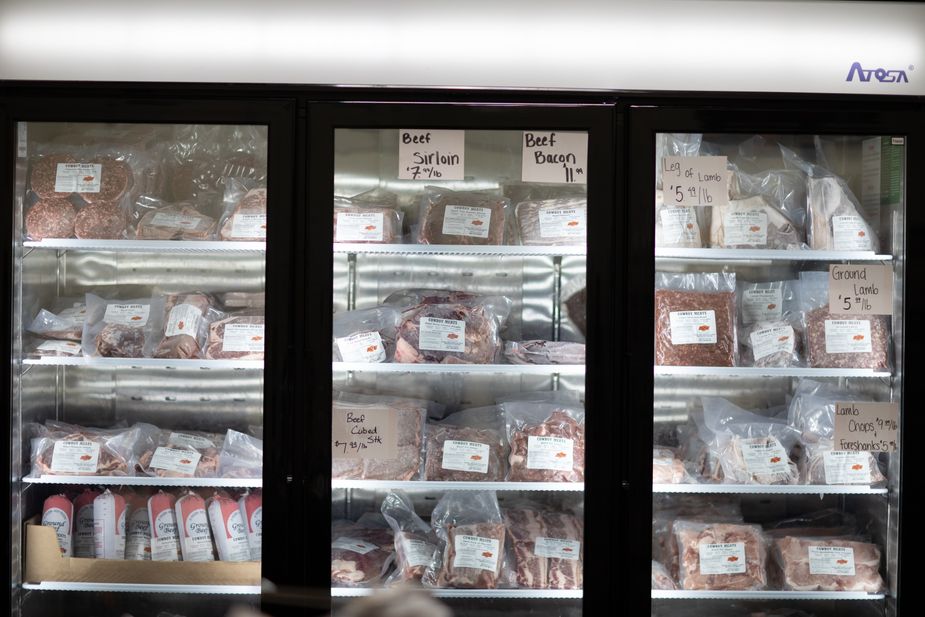
Cowboy Meats sells products like rib-eyes, roasts, chops, and sausages harvested and made by students. Photo by Brent Fuchs
With grants of inspection from the State Department of Health, the Department of Agriculture, the USDA, and the FDA, it seems there is no product FAPC can’t help bring to market.
“Private companies regularly come to FAPC, because we’re set up to jump in wherever needed when it comes to providing help on the manufacturing side or processing on the red meat side,” Jackson says. “And if something’s not working, we’ll tap the engineers downstairs.”
Even though a well-known meat brand like Bar-S has multiple production plants across Oklahoma, state and federal certifications often limit a company’s ability to develop and test new products in-house depending on what ingredients are being used. So when companies like Bar-S and others run into these roadblocks, FAPC steps in.
Bart Conley, a food scientist for Bar-S and its sister company Better Balance—both owned by Sigma Alimentos—has a longstanding relationship with FAPC. While working at Bar-S, Conley came to view the pilot plant almost as an extension of his own lab, and he currently uses FAPC facilities to advance his research into plant-based meats.
“At Bar-S, we were able to overcome a lot of hurdles—seasonal changes with ingredients, costs, and logistics—by doing the testing at FAPC,” he says.
Working with FAPC equipment, staff, and faculty gave Conley the data he needed to implement changes in multiple Bar-S facilities.
“Not only was it cost-saving,” he says, “it was also innovative.”
Oklahoma City-based entrepreneur Suan Grant brought FAPC her recipe in February 2009. She had been making award-winning Scotch bonnet pepper jelly for years before she decided to take the leap into commercial sales. When she did, FAPC was there to make sure she had a soft landing. Before the end of that year, she was filing incorporation paperwork for Suan’s Foods. FAPC helped Grant scale her recipe—“That is a science all its own!” she remembers saying—develop a business plan, manufacture product, and find a copacker for future orders. Grant’s Scotch bonnet pepper jelly can be found on market shelves across Oklahoma, and her jalapeño relish is served at Smitty’s Garage franchises statewide.
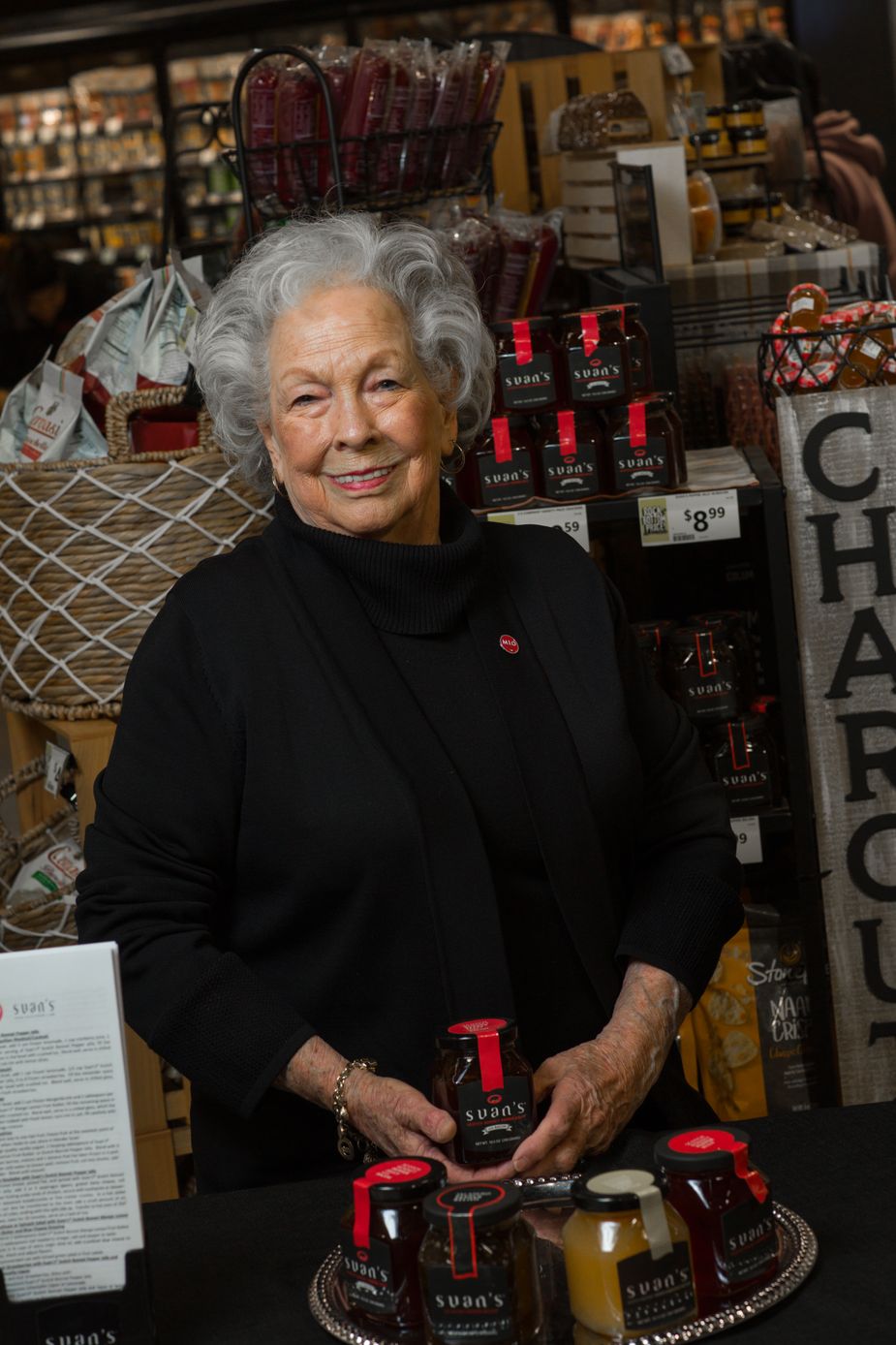
Suan’s Foods, founded by Suan Grant, is a line of condiments available in grocery stores around the state, including the newest location of Crest Foods in Edmond. Grant is an alumna of the FAPC program. Photo by Brent Fuchs
Another unique characteristic of FAPC is a continuous dedication to supporting the clients who have come here for workshops, courses, and seminars. When Grant’s copacker became unavailable during COVID, FAPC stepped in to help manufacture jalapeño relish to satisfy restaurant orders. Without the help of FAPC, Grant says, Suan’s Foods might not have survived the pandemic.
“They have all the expertise there,” she says. “And they are known for what they do throughout the United States. When you say, ‘I have FAPC behind me,’ it carries a lot of weight.”







